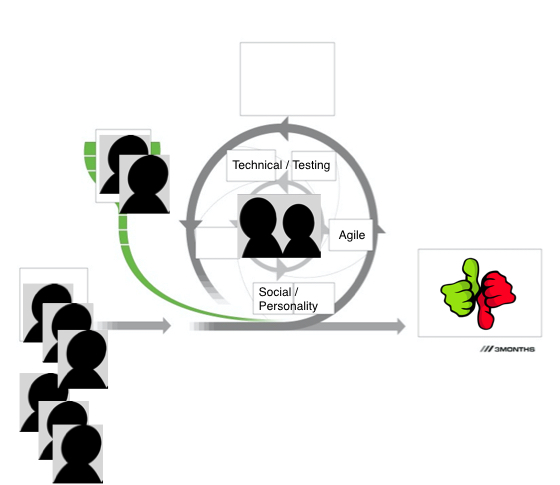Agile hiring as based on interviews we do for Tester (people who’s primary role in the team will be the testing activities).
Via twitter I came across a blog post from Cassandra H. Leung (@tweet_cassandra) about Tester Interviews: Techniques and Tasks which describes on a high level, how a diverse set of techniques can be employed to improve the interview process to find fitting candidates.
My suggestion is to read Cassandras blog post first and then come back and read the practical example.
Back in 2015 I began thinking, why the hiring process were not keeping up with the agile working way. I organized an event, where local companies and HR/recruiter/staff agencies where invited to a panel discussion.
One of the primary moments where, that some companies (e.g. Adobe Hamburg, XING) already had a layered approach of recruiting.

Out team priorities for candidates
We have a quite a product range in my (clients) team and therefore need to find out, if the candidates fit from different perspectives; for us this is mainly “testing knowledge“, “personality” and “agile working experience“.
Overview hiring process
The whole client hiring process can be broken down roughly in these steps:
- HR screening
- Technical (testing knowledge)
- Social / personality
- Meeting / lunch with team
I will write about point 2 “technical (testing knowledge)”.
Practical example
These are the elements mentioned in Cassandras blog, which we use.
- “On Site”
We do an online (video) session, where both sides can share their screens. Skype is often good enough, since its 1on1(2). - First “Testing practical”
A software fitting to the team context, there are public or open source software for most use cases, e.g. video streaming, responsive websites, applications from stores, … - Second “Testing practical”
This is based on the topic of “automation”, we use automation snippets and let the candidate read and explain it, suggest improvements, … - “Thinking out loud”
For the two practicals we encourage the candidate to speak out loud his observations, his thoughts and proceedings. We explain upfront the intention and assist with questions, if the candidate is too focused and forgets to talk. - “Three amigos”
In connection with “thinking out loud” we explain, that we will be the developer, the product owner, other stakeholders he wants to pose questions to. - “Knowledge questions”
Depending on the candidates proceeding in the practicals, we can ask about other areas, the candidate hasn’t touched or mentioned, e.g. “security”. Often the external stimulus gets the candidate unstuck or out of his (narrow) focus. - “Industry and Community Awareness”
We are interested, what ways and resources of learning the candidate uses and know.
Conclusion
With some opening small talk to ease up the interview, we spent like 10-20 minutes per practical and some open questions round in the end and we tend to finish before 60 minutes.
Most often we have two interviewer, which share the practicals and take notes.
Directly after the interview, the interviewers make a short estimate based on their current feeling and impression (thump up, down or neutral).
In the aftermath, the interviewers also summarize their notes and share them with each other; here is the time for more details in the relevant areas (personal, testing, agile).
Depending on the outcome, the next steps will be communicated.
Disclaimer:
- We try to run the same practicals, to have a kind of baseline for different candidates.
- Two interviewer should be present, to balance out human factors of the interviewers.
- The short time span of the interview will still carry the risk to over or under estimate candidates.
It is often hard to find candidates in the first place and employers should make sure, they use a more fitting hiring process to find fitting candidates on a spectrum of skills, which is relevant to the (employing) team.
Maybe this practical example can show, how different techniques can be mixed to enhance the hiring process in an (one) agile way.
How is your experience as an candidate or an interviewer?
Do you have also a practical example to share?
Looking forward,
Maik
Hi Srinivas,
thanks for the comment. Currently we (my client) does not record interviews.
With the German and European data privacy laws it might require some additional process to ask submission beforehand, keep track about the recordings for the case, that the person requests to get it deleted (especially with upcoming GPPR compliance in 2018) and other administrative tasks.
I am not sure, how much “audio” aka the voice of a person would qualify as “PII” and/or “personal data”, but I think, it could be argued that way.
PII info link:
http://www.gigya.com/blog/gdpr-difference-between-personal-data-and-personally-identifiable-information/
Also the notes are more “on the fly” meeting minutes, aka I just write down, what I have fresh in my mind.
An established “streamlined” process would of course be beneficial, e.g. so that the results of interviews can be quantified and can be more comparable from candidate to candidate.
Best,
Maik
When you do on-call (skype) Interviews, are they recorded ? #hiringtesters
And also, can you share – How Notes looks like.